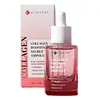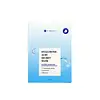What's inside
What's inside
 Key Ingredients
Key Ingredients

 Benefits
Benefits

 Concerns
Concerns

 Ingredients Side-by-side
Ingredients Side-by-side

Water
Skin ConditioningCollagen Extract
Skin ConditioningMethylpropanediol
SolventBifida Ferment Filtrate
Skin ConditioningGlycerin
Humectant1,2-Hexanediol
Skin ConditioningAlcohol
AntimicrobialButylene Glycol
HumectantCarbomer
Emulsion StabilisingPPG-13-Decyltetradeceth-24
EmulsifyingTromethamine
BufferingHyaluronic Acid
HumectantAdenosine
Skin ConditioningParfum
MaskingDisodium EDTA
Panthenol
Skin ConditioningLactobacillus Ferment
Skin ConditioningEthylhexylglycerin
Skin ConditioningCollagen
MoisturisingHydrogenated Lecithin
EmulsifyingHydroxydecyl Ubiquinone
AntioxidantLactococcus Ferment Extract
Skin ConditioningBifida Ferment Extract
HumectantLactobacillus Ferment Lysate
Skin ConditioningArgania Spinosa Kernel Oil
EmollientYeast Extract
Skin ConditioningTocopherol
AntioxidantWater, Collagen Extract, Methylpropanediol, Bifida Ferment Filtrate, Glycerin, 1,2-Hexanediol, Alcohol, Butylene Glycol, Carbomer, PPG-13-Decyltetradeceth-24, Tromethamine, Hyaluronic Acid, Adenosine, Parfum, Disodium EDTA, Panthenol, Lactobacillus Ferment, Ethylhexylglycerin, Collagen, Hydrogenated Lecithin, Hydroxydecyl Ubiquinone, Lactococcus Ferment Extract, Bifida Ferment Extract, Lactobacillus Ferment Lysate, Argania Spinosa Kernel Oil, Yeast Extract, Tocopherol
Water
Skin ConditioningDipropylene Glycol
HumectantButylene Glycol
HumectantHydroxyacetophenone
AntioxidantCarbomer
Emulsion StabilisingTromethamine
BufferingCitric Acid
BufferingAllantoin
Skin ConditioningTrehalose
HumectantPanthenol
Skin ConditioningXanthan Gum
EmulsifyingPolyglyceryl-10 Laurate
Skin ConditioningChamomilla Recutita Flower Extract
MaskingCalendula Officinalis Flower Extract
MaskingPortulaca Oleracea Extract
Skin ConditioningMalachite Extract
AntioxidantPentylene Glycol
Skin Conditioning1,2-Hexanediol
Skin ConditioningGlycerin
HumectantCaprylyl Glycol
EmollientSodium Hyaluronate
HumectantSodium Hyaluronate Crosspolymer
HumectantHydrolyzed Hyaluronic Acid
HumectantMelia Azadirachta Leaf Extract
Skin ConditioningSaccharide Isomerate
HumectantMelia Azadirachta Flower Extract
Skin ConditioningHyaluronic Acid
HumectantHexyl Cinnamal
PerfumingCitrus Aurantium Bergamia Peel Oil
Sodium Acetylated Hyaluronate
HumectantHydroxypropyltrimonium Hyaluronate
Coccinia Indica Fruit Extract
Skin ConditioningLinalool
PerfumingGlyceryl Acrylate/Acrylic Acid Copolymer
HumectantPropylene Glycol
HumectantSolanum Melongena Fruit Extract
Skin ConditioningAloe Barbadensis Flower Extract
EmollientHydrolyzed Sodium Hyaluronate
Skin ConditioningPvm/Ma Copolymer
Emulsion StabilisingOcimum Sanctum Leaf Extract
Skin ConditioningCurcuma Longa Root Extract
MaskingCorallina Officinalis Extract
Skin ConditioningSodium Citrate
BufferingWater, Dipropylene Glycol, Butylene Glycol, Hydroxyacetophenone, Carbomer, Tromethamine, Citric Acid, Allantoin, Trehalose, Panthenol, Xanthan Gum, Polyglyceryl-10 Laurate, Chamomilla Recutita Flower Extract, Calendula Officinalis Flower Extract, Portulaca Oleracea Extract, Malachite Extract, Pentylene Glycol, 1,2-Hexanediol, Glycerin, Caprylyl Glycol, Sodium Hyaluronate, Sodium Hyaluronate Crosspolymer, Hydrolyzed Hyaluronic Acid, Melia Azadirachta Leaf Extract, Saccharide Isomerate, Melia Azadirachta Flower Extract, Hyaluronic Acid, Hexyl Cinnamal, Citrus Aurantium Bergamia Peel Oil, Sodium Acetylated Hyaluronate, Hydroxypropyltrimonium Hyaluronate, Coccinia Indica Fruit Extract, Linalool, Glyceryl Acrylate/Acrylic Acid Copolymer, Propylene Glycol, Solanum Melongena Fruit Extract, Aloe Barbadensis Flower Extract, Hydrolyzed Sodium Hyaluronate, Pvm/Ma Copolymer, Ocimum Sanctum Leaf Extract, Curcuma Longa Root Extract, Corallina Officinalis Extract, Sodium Citrate
Ingredients Explained
These ingredients are found in both products.
Ingredients higher up in an ingredient list are typically present in a larger amount.
1,2-Hexanediol is a synthetic liquid and another multi-functional powerhouse.
It is a:
- Humectant, drawing moisture into the skin
- Emollient, helping to soften skin
- Solvent, dispersing and stabilizing formulas
- Preservative booster, enhancing the antimicrobial activity of other preservatives
Butylene Glycol (or BG) is used within cosmetic products for a few different reasons:
Overall, Butylene Glycol is a safe and well-rounded ingredient that works well with other ingredients.
Though this ingredient works well with most skin types, some people with sensitive skin may experience a reaction such as allergic rashes, closed comedones, or itchiness.
Learn more about Butylene GlycolCarbomer is a polymer of acrylic acid. Its main role is to create a gel consistency.
A high amount of carbomer can cause pilling or balling up of products. Don't worry, most products contain 1% or less of carbomer.
Glycerin is already naturally found in your skin. It helps moisturize and protect your skin.
A study from 2016 found glycerin to be more effective as a humectant than AHAs and hyaluronic acid.
As a humectant, it helps the skin stay hydrated by pulling moisture to your skin. The low molecular weight of glycerin allows it to pull moisture into the deeper layers of your skin.
Hydrated skin improves your skin barrier; Your skin barrier helps protect against irritants and bacteria.
Glycerin has also been found to have antimicrobial and antiviral properties. Due to these properties, glycerin is often used in wound and burn treatments.
In cosmetics, glycerin is usually derived from plants such as soybean or palm. However, it can also be sourced from animals, such as tallow or animal fat.
This ingredient is organic, colorless, odorless, and non-toxic.
Glycerin is the name for this ingredient in American English. British English uses Glycerol/Glycerine.
Learn more about GlycerinHyaluronic acid is naturally found in healthy skin. It is a humectant, meaning it draws moisture to your skin.
This ingredient helps hydrate, soothe, and protect the skin.
What makes hyaluronic acid so hydrating? It has the capacity to bind or hold large amounts of water.
Fun fact: It is already naturally found in our bodies, such as the fluids of our eyes and our joints.
Studies find this ingredient to have anti-inflammatory and anti-microbial properties. This can help speed up wound-healing.
Hyaluronic acid can be irritating if the molecule has a low-molecular weight, or if the molecules are small.
One study found low-molecular weight hyaluronic acid to be pro-inflammatory, meaning some people may experience irritation. This is because our bodies use hyaluronic acid in the wound-healing process to signal to our bodies, via irritation, that something needs healing.
The same study found high-molecular weight hyaluronic acid to be anti-inflammatory.
These are some other common types of Hyaluronic Acid:
Learn more about Hyaluronic AcidPanthenol is a common ingredient that helps hydrate and soothe the skin. It is found naturally in our skin and hair.
There are two forms of panthenol: D and L.
D-panthenol is also known as dexpanthenol. Most cosmetics use dexpanthenol or a mixture of D and L-panthenol.
Panthenol is famous due to its ability to go deeper into the skin's layers. Using this ingredient has numerous pros (and no cons):
Like hyaluronic acid, panthenol is a humectant. Humectants are able to bind and hold large amounts of water to keep skin hydrated.
This ingredient works well for wound healing. It works by increasing tissue in the wound and helps close open wounds.
Once oxidized, panthenol converts to pantothenic acid. Panthothenic acid is found in all living cells.
This ingredient is also referred to as pro-vitamin B5.
Learn more about PanthenolTromethamine helps balance the pH and improve the texture of a product. It is synthetically created.
As an emulsifier, Tromethamine prevents oil and water ingredients from separating. This helps stabilize the product and elongate a product's shelf life. Tromethamine also makes a product thicker.
Tromethamine helps balance the pH level of a product. Normal pH level of skin is slightly acidic (~4.75-5.5). The acidity of our skin is maintained by our glands and skin biome. Being slightly acidic allows our skin to create an "acid mantle". This acid mantle is a thin barrier that protects our skin from bacteria and contaminants.
Oral Tromethanmine is an anti-inflammatory drug but plays the role of masking, adding fragrance, and/or balancing pH in skincare.
1,3-Propanediol, 2-amino-2-(hydroxymethyl)-
Learn more about TromethamineWater. It's the most common cosmetic ingredient of all. You'll usually see it at the top of ingredient lists, meaning that it makes up the largest part of the product.
So why is it so popular? Water most often acts as a solvent - this means that it helps dissolve other ingredients into the formulation.
You'll also recognize water as that liquid we all need to stay alive. If you see this, drink a glass of water. Stay hydrated!
Learn more about Water